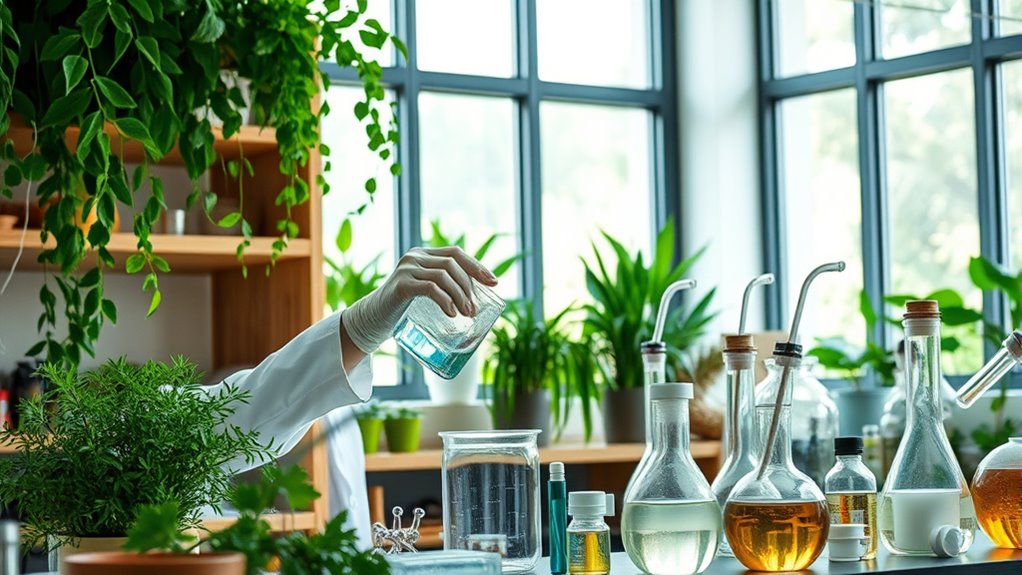Green chemistry reduces environmental impact by minimizing hazardous chemical use, optimizing resource efficiency, and adopting sustainable manufacturing methods. It promotes safer reagents, waste reduction, and energy-saving techniques like process optimization and renewable energy use. These efforts lower toxic releases, greenhouse gases, and water consumption, protecting ecosystems. Continuous innovations across industries help align practices with planetary boundaries. If you explore further, you’ll discover how these strategies work together to create a safer, more eco-friendly future.
Key Takeaways
- Green chemistry minimizes hazardous chemical use, reducing toxic waste and preventing environmental contamination.
- It promotes waste reduction and atom economy, decreasing overall pollutant generation.
- Adoption of renewable resources and feedstocks lowers reliance on fossil fuels, reducing carbon footprint.
- Implementation of eco-friendly solvents and process optimizations decreases emissions and toxic runoff.
- Innovative technologies like water recycling and process efficiency lower energy use and greenhouse gas emissions.
Significant Reductions in Hazardous Chemical Use
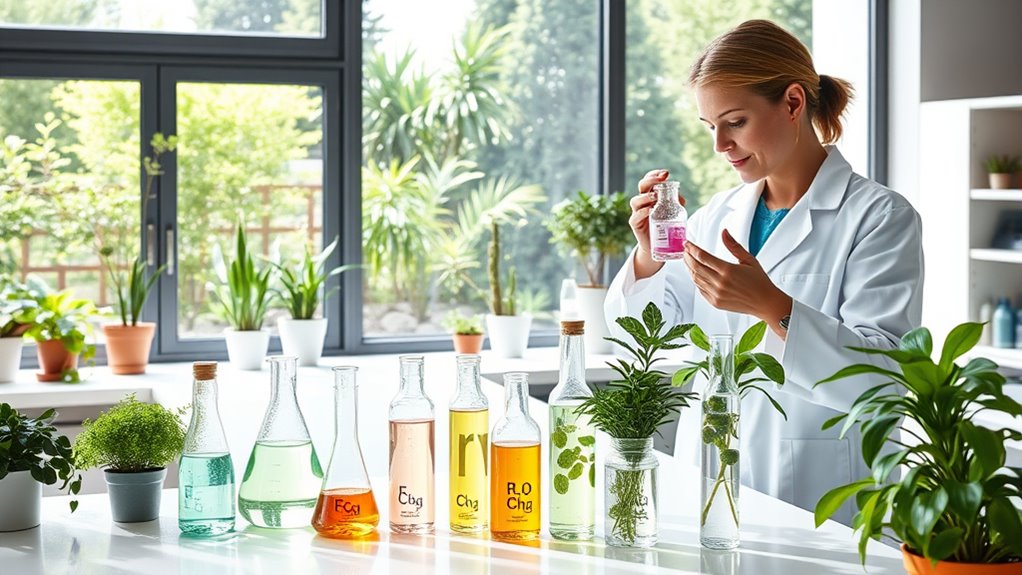
Implementing green chemistry principles has led to significant reductions in hazardous chemical use, making laboratory practices safer and more sustainable. By replacing dangerous reagents like lead nitrate, you reduce carcinogenic and aquatic toxicity risks. A new approach involves adopting best practices for safer chemicals, which further minimizes hazards and promotes environmentally friendly laboratory operations. Using the Globally Harmonized System (GHS), labs can quantify hazards and prioritize safer alternatives, achieving a 24% reduction in associated hazards. Overall, hazard levels across 10 lab guides improved by 36%. Waste streams also shrink; 20 hazardous waste types totaling over 3,285 milliliters are identified, including alcohols and sulfur salts. These efforts are supported by metrics like DOZN 2.0, which objectively measure reductions, showing scores improved for less hazardous synthesis and inherently safer chemistry. Additionally, chemical hazard classification helps laboratories better understand and communicate risks, further supporting safer practices. Incorporating hazard assessment tools, which utilize AI-driven analytics to evaluate chemical risks more accurately, enhances the ability to systematically evaluate and mitigate risks throughout chemical processes. Recognizing the importance of material selection in green chemistry can further optimize sustainability and safety efforts. Such approaches lead to safer, cleaner lab environments and promote sustainable chemical practices.
Adoption of Sustainable Production Techniques
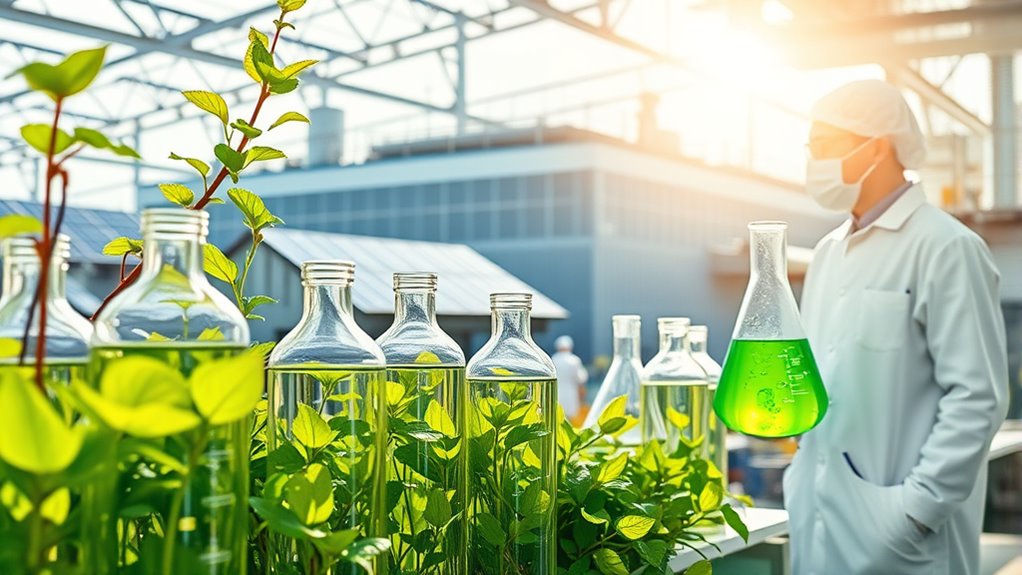
Adopting sustainable production techniques transforms chemical manufacturing by markedly reducing energy consumption, waste generation, and environmental impact. You can achieve this through process optimization, which cuts energy use by up to 50% with advanced catalysts and flow chemistry. Microwave-assisted reactions shorten synthesis times and lower energy demands, while biocatalysts enable reactions at room temperature, reducing fossil fuel reliance. Integrating renewable energy sources like solar and wind further decreases carbon footprints. Lifecycle assessment tools help identify energy-intensive steps for targeted improvements. Waste minimization strategies, such as focusing on atom economy and solvent-free synthesis, minimize byproducts and toxic waste. Using renewable feedstocks, like bio-based materials and converting agricultural waste, replaces fossil resources. Additionally, incorporating wall organization systems can improve workspace efficiency, reducing resource waste and promoting sustainable practices. Implementing energy-efficient equipment can further reduce electricity consumption in manufacturing facilities. Embracing sustainable materials management practices ensures responsible sourcing and disposal of chemical inputs and waste, which can be supported by incorporating sustainable storage solutions to prevent leaks and contamination. Furthermore, adopting process analytical technology can optimize reactions in real-time, minimizing unnecessary resource use. These techniques collectively make chemical manufacturing more efficient, sustainable, and environmentally friendly.
Economic Incentives Driving Green Chemistry Adoption

Economic incentives play a significant role in accelerating the adoption of green chemistry practices across industries. Federal and state tax credits encourage companies to develop eco-friendly products, while chemical restrictions push demand for safer alternatives. Expedited review processes help reduce regulatory delays, making green chemicals easier to bring to market. Incorporating effective sound design techniques can also enhance educational materials and public awareness campaigns related to environmental sustainability. Government purchasing mandates prioritize sustainable products, and favorable loans lower financial barriers for green startups. The market for green chemistry is expanding rapidly, with global revenue reaching $111.8 billion in 2023 and projected to hit $274.2 billion by 2032. Consumers increasingly prefer eco-conscious products, boosting demand. R&D funding, patent incentives, and cost savings from waste reduction and energy efficiency further motivate companies to adopt greener practices, aligning economic benefits with environmental responsibility. Additionally, regulatory compliance requirements are becoming more stringent, encouraging innovation in sustainable chemistry solutions.
Water Conservation Through Eco-Friendly Solvents
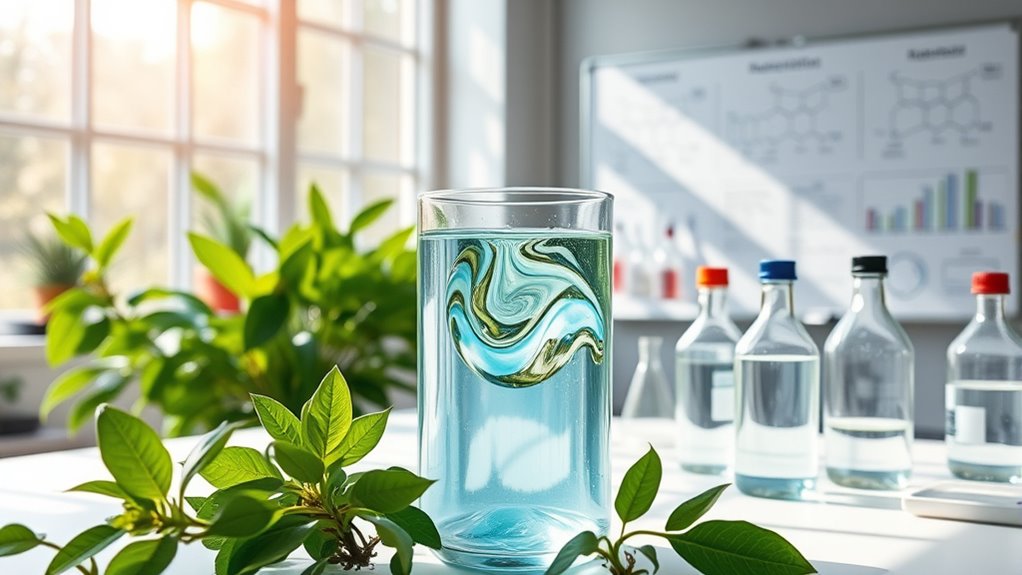
Water, as a universal and non-toxic solvent, plays an essential role in promoting greener industrial processes. Its abundance and safety make it ideal for hydrolysis, extraction, and temperature control, reducing reliance on harmful chemicals. Using water minimizes chemical waste and lowers toxic runoff into waterways, protecting aquatic ecosystems. Additionally, advancements in automation technologies can optimize water usage in manufacturing, further conserving resources. In agriculture, water supports sustainable irrigation, decreasing wastage. Implementing closed-loop systems and process optimization minimizes water use and pollution. Advanced water recycling technologies further cut freshwater consumption in manufacturing, while eco-friendly solvents like supercritical CO₂ and bio-based options help reduce contamination risks. Incorporating water-efficient practices can significantly enhance the overall sustainability of industrial operations. Furthermore, adopting water monitoring systems helps identify and address inefficiencies in water use, promoting continuous improvement in conservation efforts. Green chemistry’s focus on water-efficient methods advances environmental preservation effectively.
Lowering Greenhouse Gas Emissions and Carbon Footprint
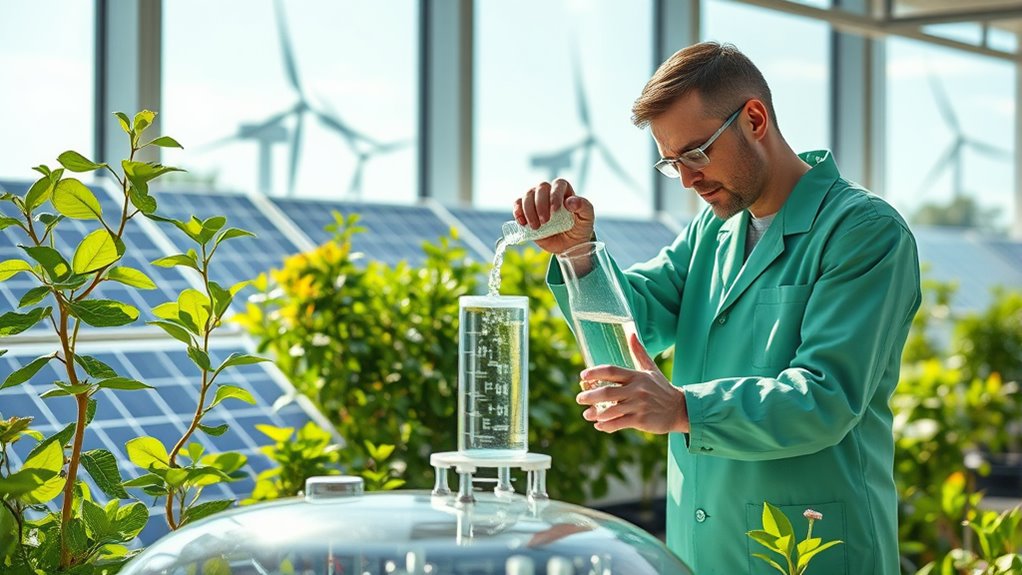
Building on green chemistry’s focus on eco-friendly solvents and water conservation, reducing greenhouse gas emissions and lowering your carbon footprint is essential for sustainable industry practices. You can adopt carbon-negative production processes, such as net-negative CO2 ethanol production, which removes 1.5 kg CO2 per kilogram of output. Using biomass-based feedstocks helps replace petroleum derivatives, avoiding fossil carbon release. Integrating carbon capture retrofits and electrochemical synthesis powered by renewable energy further decarbonizes reactions. Efficiency improvements, like continuous flow reactors and catalyst optimization, cut energy waste and emissions. In addition, understanding the maintenance and troubleshooting of related equipment can enhance process efficiency and reduce unnecessary energy consumption. Implementing monitoring systems to track emissions and energy use allows for more precise adjustments and improvements. Incorporating renewable energy sources—solar-driven reactions, wind-powered electrolysis, and process electrification—reduces reliance on fossil fuels. Leveraging off-grid renewable solutions can further enhance energy independence and sustainability. Additionally, adopting lifecycle assessments helps identify opportunities for reducing environmental impacts throughout the product lifecycle. These strategies, combined with waste-to-feedstock systems, enable you to substantially lower your industry’s greenhouse gas emissions and carbon footprint. Moreover, adopting sustainable practices can help organizations meet regulatory standards and improve overall environmental performance.
Reducing Toxic Substances Released Into Ecosystems
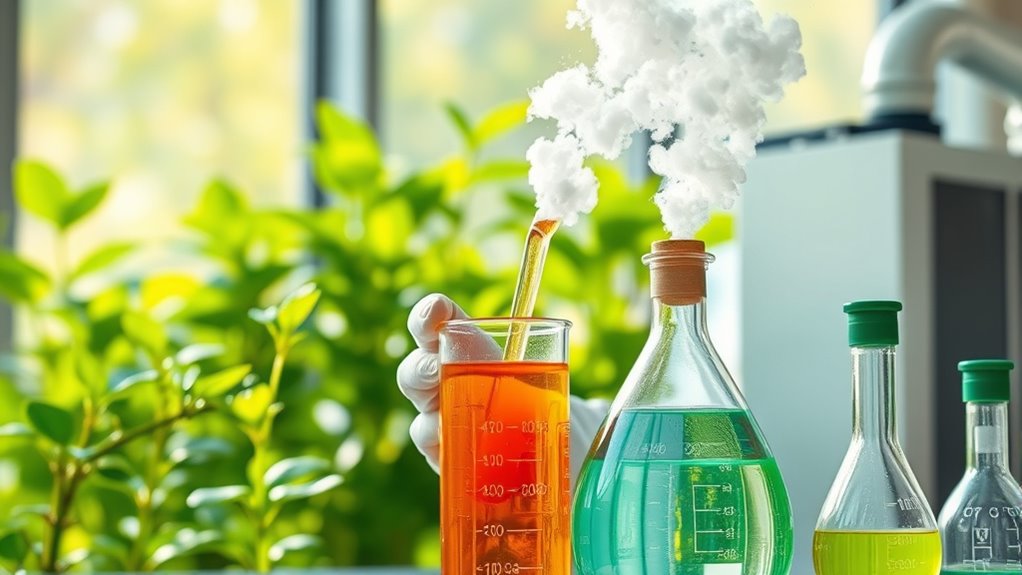
Reducing toxic substances released into ecosystems is a vital goal of green chemistry, which prioritizes preventing pollution before it occurs. Over the past decade, toxic chemical releases have dropped by 21%, with air releases decreasing by 26%, thanks to greener practices.
Manufacturing facilities have cut chemical emissions by 9%, while their economic contributions increased by 14%. These improvements are evident across regions, such as Region 8, where reductions continued between 2019 and 2020. Vetted – Mother Baby Kids initiatives support the adoption of safer chemicals and sustainable manufacturing methods.
The Toxics Release Inventory (TRI) program highlights these positive trends, showing better chemical management and pollution prevention. Quotes about the impact of fathers serve as a reminder of the importance of guidance and support in fostering sustainable practices.
Green chemistry principles—like waste minimization, atom economy, and catalytic reagents—drive these changes, helping industries adopt safer, more sustainable processes that protect ecosystems from harmful chemical exposure.
Cross-Industry Innovations for Environmental Benefits
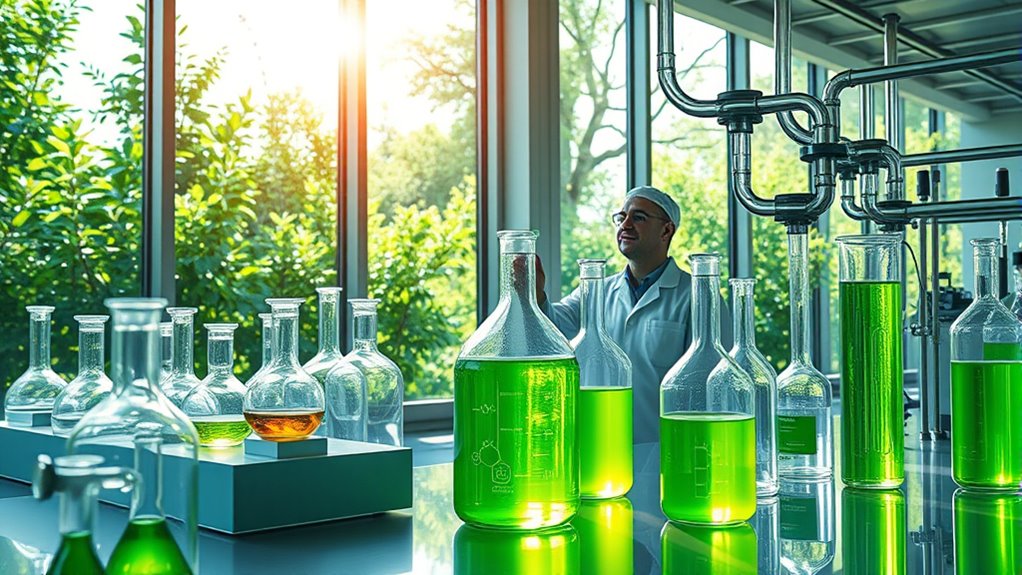
Cross-industry innovations are driving significant environmental benefits by adopting sustainable materials, optimizing processes, and fostering collaboration.
For instance, process improvements in pharmaceuticals, like eliminating ion-exchange columns and reducing freeze-drying steps, cut water and energy use while lowering costs. Redesigning processes to decrease solvent consumption by 71% further minimizes waste.
Across sectors, bio-based packaging and renewable feedstocks replace petroleum-based materials, reducing disposal burdens and resource depletion. Closed-loop designs and AI-driven combinatorial chemistry cut trial-and-error waste, making production more efficient.
Collaborative efforts between industry and academia accelerate these advances, sharing knowledge and identifying sustainable solutions.
Additionally, integrating energy-efficient systems—like continuous manufacturing, renewable energy, and waste heat recovery—reduces energy consumption and emissions, creating a more sustainable industrial landscape.
Aligning Chemical Practices With Planetary Boundaries
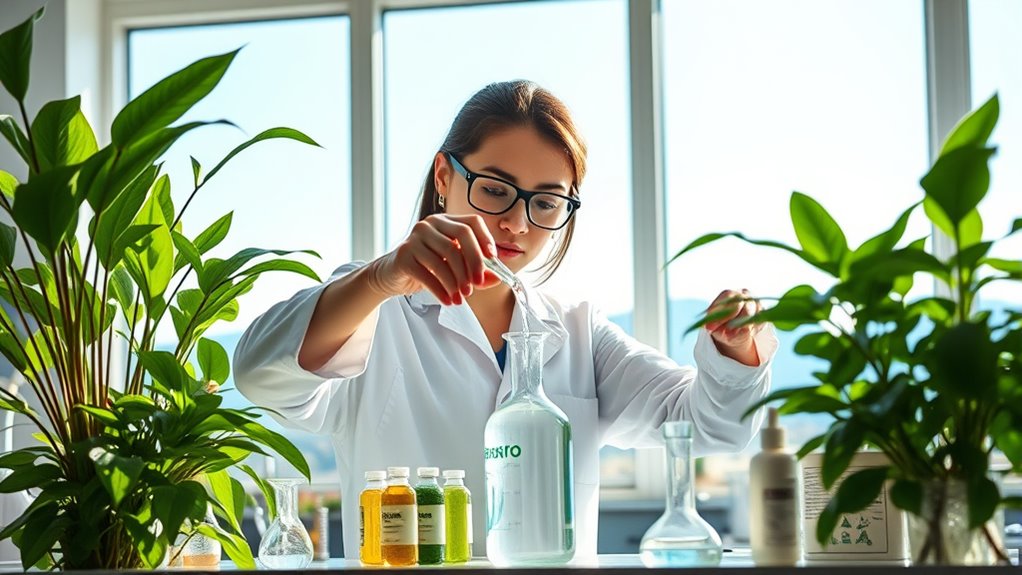
Aligning chemical practices with planetary boundaries requires a deliberate shift toward safer, more sustainable formulations and processes. You should prioritize substituting hazardous substances with safer alternatives to reduce chemical pollution risks and design biodegradable, non-toxic chemicals that respect Earth’s resilience thresholds.
Avoiding chemicals that contribute to climate change or freshwater depletion prevents boundary interactions that threaten ecosystems. You must focus on measurable impact thresholds, aligning with updated frameworks on novel entities that influence Earth system stability.
Protecting biosphere integrity involves reducing ecotoxicity, preventing ecosystem tipping points, and supporting genetic diversity through mindful manufacturing. Energy-efficient, low-GWP processes and bio-based feedstocks help mitigate climate change.
Additionally, minimizing water use, eliminating aquatic toxins, and maintaining nutrient balances ensure your practices stay within planetary limits, fostering a truly sustainable chemical industry.
Enhancing Resource Efficiency and Waste Minimization

Enhancing resource efficiency and minimizing waste are essential goals in green chemistry, directly impacting sustainability and process performance. You can measure efficiency using metrics like Process Mass Intensity (PMI), which tracks total material use per product, and atom economy, which shows how well atoms are incorporated into final products. Reaction Mass Efficiency combines yield and atom economy to assess reactant utilization.
Waste reduction is highlighted by the E-Factor, indicating waste-to-product ratios. Optimizing reaction pathways by improving yield, reducing excess reagents, and increasing selectivity minimizes resource consumption. Using catalysts, streamlining multi-step processes, and replacing solvents with greener alternatives further cut waste and energy use.
Real-time monitoring and lifecycle considerations ensure resource efficiency and waste minimization remain integral to sustainable chemical production.
Frequently Asked Questions
How Does Green Chemistry Influence Regulatory Compliance Costs?
You might wonder how green chemistry impacts compliance costs. It simplifies reporting and reduces inspection frequency by making processes inherently safer, cutting admin and monitoring efforts.
It also streamlines approvals for green products and minimizes risks, lowering liability insurance and cleanup expenses.
Plus, adaptive processes help you stay ahead of regulatory changes without hefty investments, ultimately saving money and avoiding penalties while promoting sustainable, efficient operations.
What Challenges Exist in Replacing Traditional Chemicals With Bio-Based Alternatives?
Imagine replacing a sturdy brick wall with fragile glass panels—you face challenges in ensuring strength and durability.
You might struggle with seasonal biomass availability, higher costs, and inconsistent quality.
Transportation costs feel like carrying heavy loads over rough terrain.
Material performance worries you, from weaker adhesives to durability issues.
Industry standards and consumer trust are hurdles, making it tough to shift from familiar chemicals to bio-based alternatives without risking reliability and market acceptance.
How Are Consumer Preferences Driving Green Chemistry Innovations?
You see that consumer preferences are shaping green chemistry innovations. When you prioritize sustainable products, companies respond by developing safer, eco-friendly chemicals.
Your willingness to pay more and your demand for transparency push brands to improve formulations. Millennials and Gen Z especially influence this shift, encouraging brands to align with their values.
As a result, businesses invest in greener solutions, accelerating innovation and making sustainability a core part of product development.
What Role Does Education Play in Promoting Green Chemistry Practices?
You play a crucial role in promoting green chemistry practices through education. By learning about sustainability, hazard awareness, and waste reduction, you develop the skills needed to implement environmentally friendly solutions.
Your participation in collaborative and problem-based activities enhances your understanding, making you more responsible and prepared for careers that prioritize safety and sustainability.
This education shapes your mindset, encouraging you to advocate for greener industrial processes and policy changes.
How Can Small Businesses Implement Green Chemistry Principles Effectively?
You might think implementing green chemistry is costly or complicated, but it’s actually quite manageable. Start by evaluating your current processes and making small, phased improvements like switching to greener solvents or optimizing conditions.
Engage your team through training, collaborate with suppliers, and track your progress with audits. These steps help you adopt green principles effectively without disrupting your operations, leading to long-term savings and a stronger environmental reputation.
Conclusion
By adopting green chemistry, you can substantially cut hazardous chemicals and reduce environmental harm. For example, eco-friendly solvents save up to 50% water compared to traditional methods. This shift not only benefits the planet but also boosts your bottom line through resource efficiency. Embracing sustainable practices helps you stay ahead of regulations and protect ecosystems, ensuring a healthier future for all. Making these changes now can have a profound impact—your actions truly matter.
